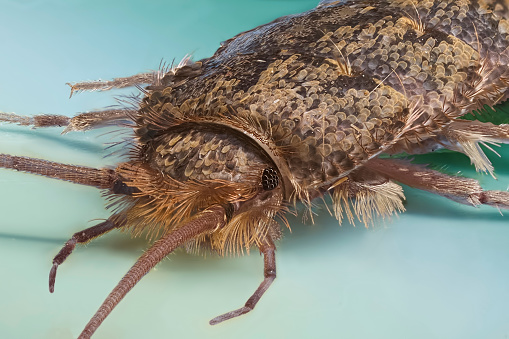Silverfish, technically known by the scientific name Lepisma saccharina, are true pest insects which you’ve very likely seen inside your home at some point. You may have spotted these little silvery-colored insects scurrying along the bathtub, up the walls, around the utility room or across a basement floor. You can find silverfish just about anywhere there’s moisture.
1. Silverfish are insects and not actually fish
Silverfish get the name because of several factors:
- They are silvery-blue in colour, much like the scales of a fish.
- They move side-to-side when they move, and that movement looks a lot like a fish tail when they are swimming through the water.
- They tend to like moist areas. That’s why you find them near drains, in sinks, bathrooms, damp basements and utility rooms.
Silverfish have long antenna on their heads and usually three appendages on their hind end. They also have two compound eyes. They don’t have wings, but do have six legs in the middle of their body that help them run very quickly along horizontal surfaces.

2. Silverfish are nocturnal
You are more likely to find silverfish in your home at night. Silverfish prefer the dark, where they will seek out food, as their compound eyes are sensitive to light. They can also feel their way along using their very sensitive antenna.
3. Silverfish eat starches
If you are finding holes in clothing, books and other fabrics, you may have been wondering if you have a pest infestation. Is it moths? Well, it might very well be silverfish.
Silverfish are not predators and do not eat other insects. They require starches to survive and their bodies need carbohydrates and protein to survive. Silverfish seek out substances high in both of these. That means they will eat fabric, clothing, paper, glue, carpeting, hair, photos, plaster, wallpaper and other materials. If you open a book and find that the pages have holes and look half-eaten, you may very well have silverfish infesting your home.
During times of extreme famine, when they really need to find food, silverfish have even been known to eat leather.
Silverfish are destructive, but they are not venomous and they are not known to be carriers of any disease. They may be unpleasant, but at least they aren’t dangerous.
4. Silverfish have been around for a LONG time
Silverfish are believed to be one of the oldest and most primitive insects alive on planet Earth. Fossils of silverfish have been traced back as far as the Paleozoic Era. It is thought by some scientists that silverfish and their cousins, the Bristletail, go back over 400 million years.
5. Silverfish can run very fast
Since silverfish do not have fangs and do not carry any venom, they really have no defense against predators. They cannot fight back. That means their only means of defense is their speed. Their size means that they might not be able to entirely outrun a human, but they have been known to even outrun centipedes and wandering spiders, both active hunters known to move quickly.
The one caveat is that silverfish are only that fast when running horizontally. They have no additional appendages that let them move fast vertically. Silverfish may be able to run up a wall, but they will not be as quick and are easier to catch. However, give the pests a straight track upon which to run and they might as well be tiny thoroughbreds.
How to Get Rid of Silverfish?
Don’t deal with a silverfish infestation on your own. If you have been seeing these pests around your home, contact the experts in pest control at Rentokil. We can help you get rid of silverfish and offer advice on preventing them from returning, too.

